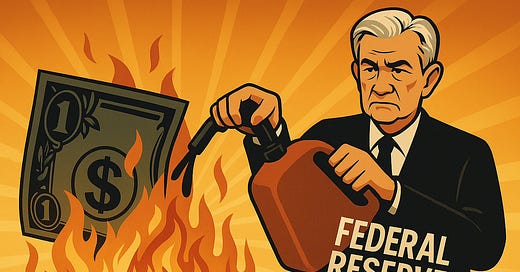Money is not wealth. It is a medium of exchange. Yet for over a century, politicians and central bankers have treated money as though creating more of it magically creates prosperity. It does not. What it does is to erode the purchasing power of every preexisting dollar. This erosion of value is no accident. It is the inevitable consequence whenever the Federal Reserve increases the money supply.
If the average citizen wonders why a dollar buys so little today compared to what it did in the past, one need only look at the deliberate policies of the central bank. Since the creation of the Federal Reserve in 1913, the dollar has lost more than 95% of its value. Whenever money creation outpaces economic growth, the dollar loses purchasing power.
To understand why, let’s consider the basic economic principle of supply and demand. If you increase the supply of something faster than the demand for it, its value falls. This is true whether you're talking about potatoes, baseball cards, or money. Likewise, when the Federal Reserve increases the amount of money in circulation, each dollar is able to buy less.
In the early 20th century, the United States was on the gold standard. A dollar represented a unit of weight, convertible into gold. This limited how much money could be created. But with the abandonment of the gold standard — first domestically under FDR in 1933, and then internationally under Nixon in 1971 — the floodgates opened. The dollar was no longer anchored to anything of intrinsic value. From that point forward, money creation became a political and bureaucratic tool.
The consequences were immediate and far-reaching. Consider this: in 1971, the average price of a new home in the United States was around $25,000. Today, it is well over $400,000. A donut that sold for 5 to 10 cents in the 1970s, now sells for about $1.50. That exponential increase reflects the degree to which the money supply has been increased.
Critics will say increases in the price of products are a natural feature of a growing economy. But inflation is not an act of God, it is a deliberate policy. Between 1800 and 1900, prices actually fell by 50% despite it being a century of expansion.
It is not prices that rise so much as it is money that falls in value. A gallon of gasoline does not become more expensive because the molecules have changed. It becomes more expensive because the dollars used to buy it have been watered down and are worth less.
There is a cruel irony here: the very people most hurt by inflation are those with the fewest assets. The wealthy can protect themselves by owning real estate, stocks, or commodities — all of which tend to rise with inflation. But the poor and middle class live on fixed wages, savings accounts, and pensions. When the Federal Reserve prints more money, they do not get richer. They get robbed.
In the short term, printing money stimulates the economy. It boosts asset prices and allows the government to borrow more without immediately raising taxes. But what comes after? Higher prices, distorted incentives and economic pain.
For example, after the 2008 financial crisis, the Fed embarked on an unprecedented program of quantitative easing (a form of money creation), ballooning the amount of money in circulation from about $8 trillion to over $18 trillion by the early 2020s. The COVID-19 pandemic added fuel to the fire, as trillions more were created to fund stimulus packages. The result was that inflation surged. By 2022, inflation reached a 40-year high (9.1% in June), erasing years of real wage gains and hammering household budgets.
Nonetheless, the appetite for money creation persists. Why? Because it allows our elected politicians to spend (often buying votes) without directly taxing, shifting the burden to ordinary citizens through what economists call the “inflation tax.” Unlike a sales tax, which is visible, the inflation tax is hidden. People feel the pain but often blame “greedy corporations” or “supply chain disruptions,” failing to identify the true source.
In the end, the Federal Reserve’s power to create money is a power to destroy value. It is a power to shift wealth from savers to borrowers, from the responsible to the reckless. It is an exploitation of central planning masquerading as economic management.
In a free society, money should be a store of value, not a tool of manipulation. Until that principle is restored, the buying power of the dollar will continue to erode — and with it, the financial future of the very people central bankers pretend to protect.
If you had put $10,000 in a bank account in 1913 earning an average of 2% annual interest (currently under one percent), by 2025 it would have grown to approximately $91,880. But, had you purchased $10,000 worth of gold that same year, it would now be worth in excess of $1.6 million.





This substack is a true national treasure.
Beautiful. Concise, and easily understood by those (such as myself) to whom economic principles have always seemed a bit daunting.
Thank you!